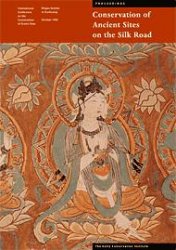
Conservation of Ancient Sites on the Silk Road
Author: composite authors
Getty Publications
1997
Pages: 420
Language: English
Format: pdf
Size: 26.13 Mb
The Mogao Grottoes, a World Heritage Site near Dunhuang City in the Gobi Desert, is located on the ancient caravan route that once linked China with the West. Nearly 500 of these grotto temples remain. This volume of symposium proceedings marks the culmination of a unique three-year Getty Conservation Institute collaborative project with the Chinese authorities and discusses various approaches to site managementas well as conservation principles and practice and geotechnical and environmental issues.
THE GETTY CONSERVATION INSTITUTE is committed to the preservation of the world’s cultural heritage and, as such, seeks to find ways to enhance the knowledge and information available to conservation professionals as well as to a broader audience. These proceedings are part of that commitment. They have been long in the making, but waiting for them has been worthwhile.
The International Conference on the Conservation of Ancient Sites on the Silk Road, sponsored by the Getty Conservation Institute together with China’s Dunhuang Academy and State Bureau of Cultural Relics, took place in October 1993 at the Mogao grottoes, Dunhuang, the People’s Republic of China. Since then, several other meetings have been held. They all shared in the objectives of the initial conference: to bring together an international panel of specialists from a wide range of disciplines to provide a critical mass of expertise that would or could be applied to solving the difficult and numerous problems that threaten some of the world’s most imposing and important cultural heritage sites, the magnificent Buddhist grottoes on the Silk Road.
Grottoes pose particularly thorny problems for conservation. They require a fundamentally holistic view if the conservation approach is going to be valuable in the long term. At the same time—because of their magnitude, geographic location, richness and variety of materials, unique microclimates, continuing use as religious sites, and growing attraction for tourists—the Buddhist grottoes of the Silk Road require dedicated study with a variety of disciplines to understand their deterioration problems and appropriate methods of prevention. The conference on which these proceedings are based marked the first time that scholars and scientists from the West and China had convened at a heritage site in China for the common purpose of providing information, exchanging ideas, and devising mechanisms to save grotto sites. The essays assembled here represent contributions from Australia, Canada, France, Germany, India, Japan, Singapore, Sri Lanka, Switzerland, and the United Kingdom, as well as China and the United States.





 Register!
Register! World History
World History









